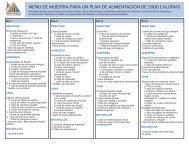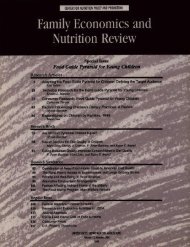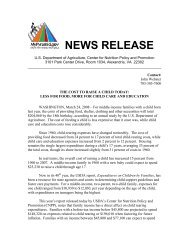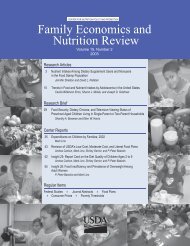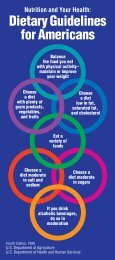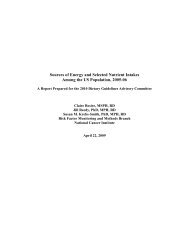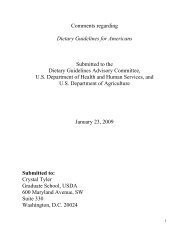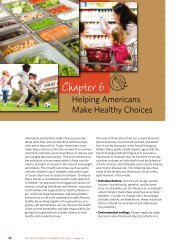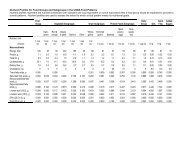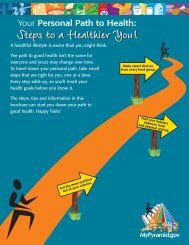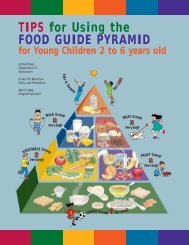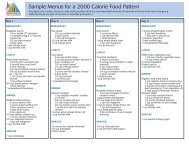Elderly Nutrition - Center for Nutrition Policy and Promotion - US ...
Elderly Nutrition - Center for Nutrition Policy and Promotion - US ...
Elderly Nutrition - Center for Nutrition Policy and Promotion - US ...
You also want an ePaper? Increase the reach of your titles
YUMPU automatically turns print PDFs into web optimized ePapers that Google loves.
Factors Affecting <strong>Nutrition</strong>al<br />
Adequacy Among Single <strong>Elderly</strong><br />
Women<br />
Deanna L. Sharpe, PhD<br />
S<strong>and</strong>ra J. Huston, PhD<br />
Michael S. Finke, PhD<br />
University of Missouri-Columbia<br />
Data from the 1994-96 Continuing Survey of Food Intakes by Individuals <strong>and</strong> the<br />
Diet <strong>and</strong> Health Knowledge Survey were used to assess the relative importance<br />
of factors associated with the quality of the diet of single women age 65 <strong>and</strong> older.<br />
Findings indicated that higher levels of nutritional adequacy were associated with<br />
Midwest residence, daily intake of a multivitamin/multimineral, higher levels of<br />
income, <strong>and</strong> the presence of circulatory disease. Lower levels of nutritional<br />
adequacy were associated with employment, receipt of food stamps, <strong>and</strong> rural<br />
residence. Results confirm the importance of providing healthful meal options to<br />
single elderly females who may be faced with fewer financial resources, reduced<br />
mobility, or higher costs associated with obtaining food.<br />
N<br />
utritional adequacy among<br />
the elderly interests an aging<br />
U.S. population. In 1996,<br />
12 percent of Americans were over<br />
age 65. By 2050, this elderly population<br />
is projected to more than double<br />
as members of the large baby-boom<br />
generation reach their elder years.<br />
Within this population, the fastest<br />
growing segment is expected to be<br />
those over age 85 (U.S. Department<br />
of Commerce, 1995).<br />
For elderly individuals, inadequate<br />
nutrition can increase the incidence<br />
<strong>and</strong> severity of disease <strong>and</strong> also hasten<br />
loss of independence. But, the ability<br />
to choose a diet with sufficient quality<br />
<strong>and</strong> variety to meet daily nutrient<br />
needs may be affected adversely<br />
by the pathological, physiological,<br />
economical, <strong>and</strong> social factors that<br />
accompany aging. Reduced physical<br />
activity <strong>and</strong> lean body mass decrease<br />
requirements <strong>for</strong> food energy <strong>and</strong><br />
increase the need <strong>for</strong> nutrient-dense<br />
foods (Haller, 1999). Gradual loss of<br />
health due to the effects of chronic<br />
diseases, such as arthritis or diabetes,<br />
can impair the ability to obtain, prepare,<br />
<strong>and</strong> enjoy nutritious foods (Hendy,<br />
Nelson, & Greco, 1998). Qu<strong>and</strong>t <strong>and</strong><br />
Chao (2000) note that women, more so<br />
than men, report chronic problems with<br />
oral health <strong>and</strong> digestion, the need <strong>for</strong><br />
special diets, diseases interfering with<br />
eating, <strong>and</strong> anemia.<br />
Background<br />
Lower levels of economic resources<br />
are associated with a greater risk of<br />
experiencing hunger <strong>and</strong> food insufficiency<br />
(Brown, 1987; Sahyoun<br />
& Basiotis, 2001). Qu<strong>and</strong>t <strong>and</strong> Rao<br />
(1999) found that having an income<br />
less than 150 percent of the poverty<br />
level was a relatively strong predictor<br />
of food insecurity <strong>for</strong> Appalachian<br />
Kentucky residents age 65 <strong>and</strong> older.<br />
Hendy et al. (1998) noted that food<br />
cost was frequently mentioned as a<br />
barrier to obtaining adequate nutrition<br />
<strong>for</strong> rural elderly in the Eastern United<br />
States. Low economic resources can<br />
also affect the quantity <strong>and</strong> quality<br />
of food purchased, especially if an<br />
74 Family Economics <strong>and</strong> <strong>Nutrition</strong> Review



